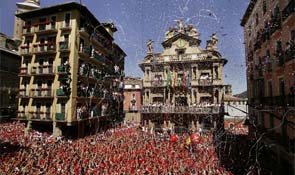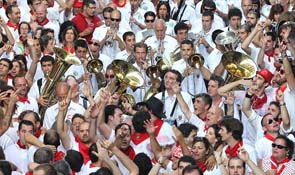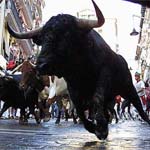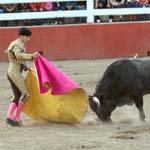San Fermin Festival
The worldwide famous San Fermin Festival –also called Sanfermines by the locals- is a huge celebration that takes place in the northern city of Pamplona every year in July, from the 6th to the 14th of that month. It is one of the best known festivities in Spain.
The origin of the feast is a mix of two medieval events that happened in the city of Pamplona. On one side, we find the celebration of commercial secular fairs, including a big cattle fair that eventually led to the organization of bullfighting as a side activity, as early as the 14th century. Bullrunning, though, was first documented in the 17th century. Together with this, there’s the cult of San Fermin, the city’s first catholic bishop, who was beheaded on a preaching trip to France, and thus considered a martyr in the Catholic Church. The religious ceremonies celebrating the saint were originally held on October 10th, until 1591, when they were transferred to July 7th, to make them coincide with the local cattle fair and also because people were tired of the typical bad weather in Pamplona around the fall.
Single Day events
The Chupinazo

The Chupinazo is the start kick of the San Fermin Festival, an event that takes place on the 6th of July at precisely 12 o’clock. It consists of a brief speech given out by one of the city’s political representatives or a local celebrity, in which the figure of San Fermin is praised and exalted, and after which a rocket (chupinazo) is released. The Town Hall square is packed with people from a couple hours before the event, and for most people, this event represents the last moment of sobriety in the next seven days.
Riau Riau

Traditionally being held also on the 6th of July, the Riau Riau was a massive event in which the whole town took part. The members of the city council were meant to walk from the Town Hall to the nearby San Lorenzo church, and the protesting locals blocked their way as they intonated the "Astrain Waltz", a mid-XIX century composition. Because of the violent political tone in the event, it stopped taking place in 1991, although some of the city’s elders organize an alternative Riau Riau to keep the tradition alive.
The more religious part of the celebration takes place on July 7th, when the medieval statue of San Fermín is accompanied on procession by thousands of people along the streets of Pamplona, as well as a Giants and big-heads parade together with the local politicians.
On midnight of July 14th, after nine days of celebrations, the people of Pamplona gather at the Town Hall Plaza to intonate the notes of Pobre de mí (Poor me), a half-ironic tragic song that puts an end to the festival.Daily events

The best known aspect of the San Fermin Festival is the running of the bulls (encierro in Spanish, from the verb encerrar, to lock), which takes place every day from the 7th to the 14th at 8 in the morning. It is also the aspect that has drawn the most international attention towards the festival, since Ernest Hemingway praised the unique atmosphere of the festival in his 1926 novel The Sun Also Rises. Hundreds of people take part in a race where six bulls and six steers go over an 825-meter course through the narrow streets of Pamplona’s old town up to the bullring, where the race ends. There, and once the fighting bulls are taken away to wait for the evening’s corrida (bullfight), the crowd is allowed some minutes to run around teasing the steers.
It is a dangerous event (15 people have died since 1925, and some 250 people are injured every year), so if you would like to participate, there are some common-sense rules to respect if you want to take part in the running:
Common-sense rulesfor running the bulls
- Don't try to touch the bulls; you will be taking the risk of getting his attention over yourself.
- If you fall down, don't try to rise; protect your head and lie in fetal position until the bulls pass.
- A bull runs faster than you
- A single bull becomes more dangerous than mingled with the group
- Take the bend of Mercaderes street from the interior side, as the bulls often hit or fall in the exterior side and could squash on the walls.
- Don't take your backpack or photo camera with you while you run
Every day at 6:30pm takes place the bullfight (corrida) in which the six fighting bulls that ran the encierro that same morning are slain in the bullring. Normally, all tickets for theses events, taking place from the 7th to the 14th, are sold out months in advance. One of the peculiarities of it is that, contrary to what's accustomed in other bullrings, people drink and eat typical products like chistorra, cheese, or local wines. Many other towns celebrate bullfights around this time, so if you want to live the full Spanish immersion experience, don't doubt to book your holidays for a longer period!

Another big event that takes places every day is a parade of Gigantes y Cabezudos (Giants and Big-Heads, respectively) in the old town of Pamplona. This act still preserves the eight original figures of the Giants, made of wood, carton and cloth in 1860 by Tadeo Amorena, though the presence of giants in the San Fermin celebration is documented as early as the XVI century. They represent pairs of kings of different races and places. Five Big-Heads, six horsemen (zaldikos), and six kilikis –smaller figures representing a sort of courtiers- parade together with them.
Also taking place every day, in the nearby Plaza de los Fueros, there is a show of traditional Navarre and Basque rural sports, such as stone lifting (Harrijasotzaileak), wood cutting (Aizkolaritza) or hay bale lifting, as well as the very renowned Jai alai (Basque pelota) tournament.
Also happening every night is a fireworks spectacle at the citadel park, an event that’s been happening as far back as 1595, and which in 2000 turned into an international competition.

 Ever wondered why the runners dress in white clothes with a red bandana around their neck? Some claim it was a decission of one of the associations to stand out from the rest, while other say that it is a reminiscent of the traditional Basque-French outfit.
Ever wondered why the runners dress in white clothes with a red bandana around their neck? Some claim it was a decission of one of the associations to stand out from the rest, while other say that it is a reminiscent of the traditional Basque-French outfit. 